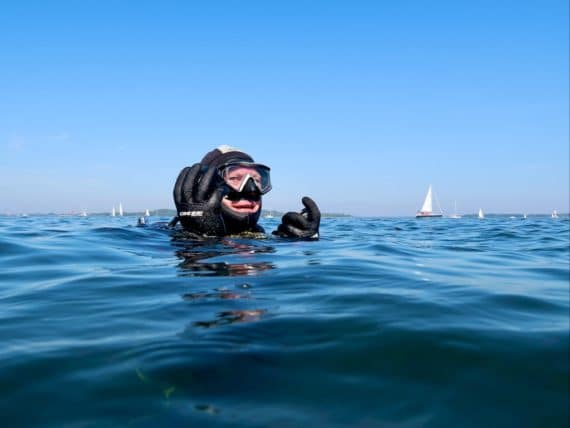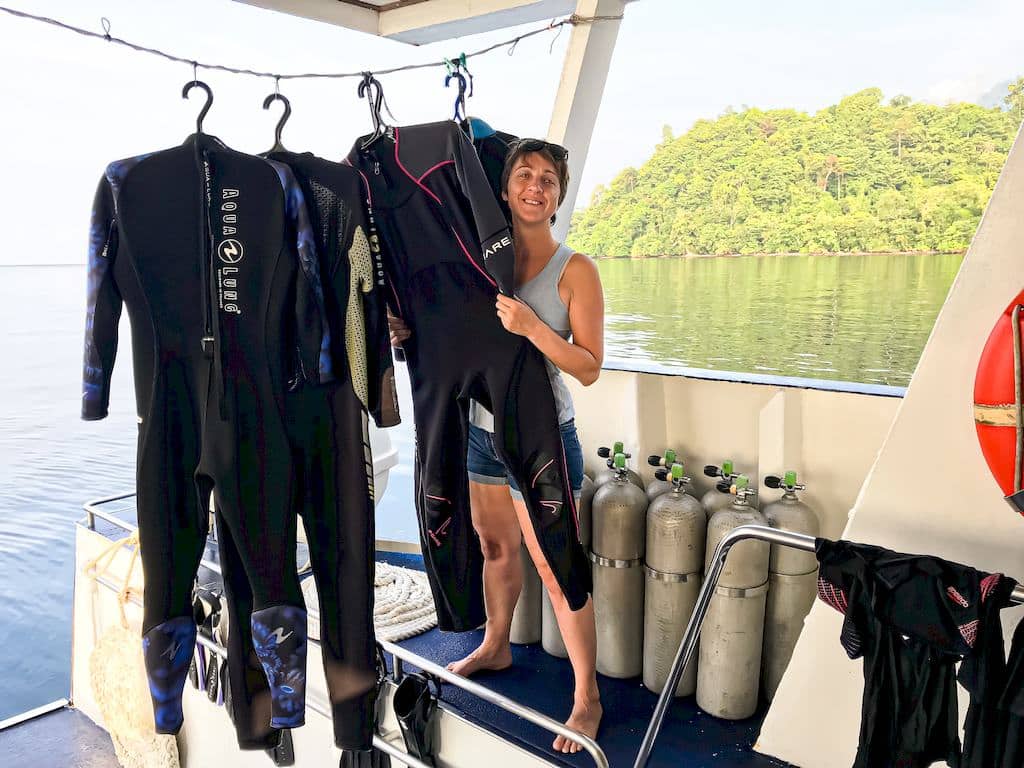Why I decided to stop teaching the use of dive tables

A few months ago, I participated in the training of a group of divers wishing to obtain a level of autonomous diver at 40 m. Since the teaching of the tables (especially for successive dives) as a decompression tool is still on the agenda within the majority of diving organizations. I have asked myself the question of the relevance of this learning and suggested that it be deleted in favor of the perfect knowledge of diving computers.
After a long discussion with my companion (Course Director and diving instructor for almost 20 years). We decided to share with you the fruit of our reflections.
Let’s go back : a little bit of history of decompression tool
The man began to immerse himself a long time ago. At first he stayed at a certain depth for an certain time without really asking too many questions. And he came out of the water when it suited him.
Late 19th century, early 20th century, things change as more and more people go underwater or in hyperbaric environments. This results in more observations and findings.
Quite quickly, we realize in a more pertinent and correlated way that sometimes the return to normobaric pressure (on the surface), the person does not feel well. Encounters a real problem, or more dramatically dies … and this raises a question.
When science is involved (here we must cling 🙂 )
From then on. Names such as Haldane, Buhlmann, Workmann and others plan to understand what is happening and to try to find solutions to avoid or minimize the problems encountered.
Without going into details (it would take a much longer text than this article). They put forward the bases of the concept of decompression in diving.
Well known to divers. This concept explains the passage of the gas phase of nitrogen (or helium, but this is not the subject of this article) to the dissolved phase in compression and the fact that. The other way round, it is pathogenic to carry out a rapid gas return without using a specific protocol encompassing the time-depth concept.
For years, these researchers have tried to understand the functioning of the human body. And to try to model it, among other things, by categorizing or compartmentalizing zones of our organism.
The beginnings were not perfect
But this model called “bubble model” was initially quickly adopted by almost all those who were developing tables and decompression tools. Everyone, however, bringing his touch to be the most accurate or the most effective.
The results of the experiments and studies of these researchers have been recorded in tables. Whose evolution is what we now call the dive tables or decompression tables.
There are many different dive tables.
By limiting ourselves to recreational or sport diving and the use of air as a respiratory gas for our explanation. We can say that most diving tables take into account a limited number of “compartments“. Usually 8 to 16, defined as a part of the body (eg blood, bones, fat, …)
To put it simply, the theoretical cutting into different compartments is used to represent the functioning of the body during compression-decompression.
If the compartments were the only ones concerned with the explanation of the decompression, the work of the researchers would be made simpler but of course it is not and many other parameters (of which I will not speak in this article ) are used to develop dive tables.
Unfortunately, dive tables are not infinitely expandable in terms of the information they give and the parameters with which they are designed.
It is therefore necessary to make choices about the information they contain.
We note, for example, that the US NAVY were created on the basis of a man. And not a woman, young and very healthy, able to make significant physical efforts, …
The divers in 2017 are often far away from this model … And the world of diving was also open to women. Who were not part of the population samples observed during the initial research.
Do you still follow me ? So we continue … 🙂
About diving tables as a decompression tool
As mentioned above, it must be taken into account that the tool (the “dive table” part) has physical limitations. It is not possible to carry a water-resistant and large document that can include a lot of information!
The dive tables therefore had to be optimized and simplified to be transportable. (often 20cm X10 cm or 15cm X 15 cm). It was therefore decided to use time and depth in small numbers to fit on a document of reasonable size.
As a tool, the dive table is only one of three elements for decompression during a dive. At the dive tables, you must add a depth gauge (to know its depth). And a stopwatch (to know the time) … and of course you need to use your brain 😉
It is also important to keep in mind that the dive tables were designed to perform one or two dives a day. (sometimes three) but no more to my best knowledge.
For many years the divers had to be happy with these 3 elements to make their dives and the possible deco stop with the inherent limitations. But they had no choice and had to do with the tools available to carry out their decompression if needed.
The arrival of a new decompression tool : the dive computer
More recently with the evolution of knowledge and technologies, dive computers have appeared. First very simple and some of them maybe moderately reliable and then more and more successful.
Currently, there are many models, but especially the oldest, are based on tables from the research of Haldane and colleagues.
Besides the work of these first researchers, new concepts and models of decompression have appeared. Bruce Wienke’s RGBM and David Yount’s VPM. Attracted the attention of the dive equipment manufacturers who seized these new research results. They took advantage of this, by associating them with the technological innovations of the time. To build modern and reliable dive computers that are more compact, easier to read (even for divers with presbyopia problems) and giving results closer to our physiological reality.
These computers, thanks to miniaturization and electronics. Enable the compilation of a very large number of parameters to obtain a real time and depth calculation for a size often half of the smallest “paper / plastic” diving tables.
Some will also say that the magic of modern times makes it possible to buy today a quality computer for 150 € or sometimes less !
Why it’s important to trust your dive computer
Who today can imagine diving without a dive computer ?
Modern computers, unlike dive tables, allow many customized settings for our safety and comfort of diving:
- They provide greater accuracy of our decompression in real time and course from day to day or even dive after dive. The decompression is then carried out taking into account the underwater travel actually performed. And not simply following a square dive as is the case for a table.
- Dive computers are not sensitive to narcosis. And allow a precise and adapted calculation whatever the depth thus reducing the “human” calculation error 😉
- Many computers make it possible to dive with air and Nitrox (sometimes with helium). And / or the fast switch from one gas to another.
Dive computers equipped with a pressure probe can, in real time. Notify the diver to adjust his depth and / or dive time according to his consumption.
- Other dive computers take water temperature and diver’s heart rate into account to adjust decompression
- The computers allow the diver to harden his decompression protocol for his own reasons. (eg fatigue, age or simply a large number of dives during the week in the case of a cruise).
- More and more computers are offering or imposing deep stops. These are mainly derived from Wienke (RGBM) or Yount (VPM) work relating to decompression profile holistically. Or from Baker and Pyle referring just to the deep stop.
- Computers also have this feature of having a memory. And therefore unlike a table that assumes desaturation completed after 24 hours, dive computers can give you long desaturation times of up to 36 hours or more. For divers who went on a cruise, on vacation or for work and made 3, 4 or 5 dives a day. The computer will increase their safety during the week by taking into account this accumulation of dives. At the end of the week the computer will impose a longer no fly time for example.
Dive tables, still useful ?
Clearly, I never use a dive table anymore as a decompression tool. And it’s been a long time since I bought a second dive computer for reasons of redundancy, although I never had a real computer failure during a dive.
The difference in price between a computer and the set of “a table + a quality depth gauge + a quality stopwatch” is so minimal that the choice of redundancy is made very quickly.
To be honest, I have never seen a diver using dive tables as a means of decompression since years. Similarly, I have never personally ever dived with a diver using dive tables as a decompression device. And I would refuse this type of diving at a time when progress allows us to use other tools much more secure.
Although they have been useful for years. Considering all the advantages of diving computers, I have not found any arguments in favor of using tables as a means of decompression in 2017.
But then, if they are no longer useful, must we still teach the tables ?
This is a question that we are entitled to ask ourselves because, even if there are rumors that some major American certification agencies would like to eliminate their use in training, the learning of dive tables is still widespread .
As far as I am concerned, the result of our reflections explained above led me to no longer teach the tables except for the basic theoretical concept. And the historical research carried out by the pioneers, Haldane et al. and not anymore to make tireless calculation exercises that will definitely not stick to the reality of the dives that divers will perform.
But, you will say, should we not understand how to use the tables if we want to know the operation of the dive computer or the decompression theory ?
For me the answer is clearly NO.
The dive computer AND the dive tables are both TOOLS for decompression.
On one hand we have a modern and dynamic tool offering the many advantages listed above. On the other hand, we have a fixed tool the tables do not adapt to the course or to the divers.
However, feel free to use the decompression tool that you considers the most secure. The best performing or the most adapted to your profile.
On the other hand, in the training of the divers that I train. The study and understanding of the compression-decompression process is emphasized as well as that of the operation of their personal computer, including the control of the planning mode based on the information of computers.
This part of the training is very useful because it forces the candidate to be interested in his computer. (who reads the manuals ???) but also to that of the others. This exercise puts the diver into the reality of a dive that sees only rarely. (not to say never). All divers equipped with the same dive computer.
My aim is to make every diver aware of the importance of knowing his decompression tool, to be able to make the main adjustments and to adopt an efficient approach for dives with pleasure in complete safety.
In the same spirit, after the “try scuba” dive, I always lend a dive computer to a candidate so that he can, from his first immersion, learn to check his parameters and become rapidly autonomous as to the control of his dive.
Since 2017, therefore, it seems more important for me to coincide the theoretical learning of diving with the reality to which divers will be confronted.
In conclusion
Unlike dive tables, more and more computers are available with features that allow for a more comfortable, accurate and safe dive.
This represents the evolution and it will continue even if we don’t like it or if we like it. It is therefore more than advisable to use current and efficient tools in 2017 and not the old devices of the beginnings of diving, although at the time they were the only ones available for the use of the diver.
And it is not “Because we always did like this” that we can not change otherwise as an illustration by the absurd one could say that it is unthinkable to drive today in a car equipped with ABS, airbag, GPS, power steering, … Who wants this?
As a result, learning how to use tables as a decompression tool seems to me totally obsolete, and I believe that instructors will give a definite advantage to their candidates by focusing the training on the understanding of compression-decompression AND the precise use of diving computers.
I realize that my remarks may seem unusual but I am convinced that at some point we must think and position ourselves taking into account the evolution of the world of scuba diving that we all enjoy.
Hoping that this reflection will spark yours and allow us to participate together in enriching this exciting universe, I encourage you to question the learning, the achievements, … and to think more positive and further.
Want to share your experiences, comments and questions ?
Post a comment below … it will be my pleasure to exchange with you live 😉
Good bubbles and do not forget to be happy 🙂
Helene
PS: What if we stay connected? Go to our Facebook page or subscribe to our newsletter
For more information about decompression tool :
Wienke, Bruce R; O’Leary, Timothy R (13 February 2002). “Reduced gradient bubble model: Diving algorithm, basis and comparisons” (PDF). Tampa, Florida: NAUI Technical Diving Operations. pp. 7–12. Retrieved 12 January 2010.
Pyle, Richard L. (1997). “The importance of deep safety stops: Rethinking ascent patterns from decompression dives”. Journal of the South Pacific Underwater Medicine Society. South Pacific Underwater Medicine Society. Retrieved 9 March 2016.
Yount, DE (1991). Hans-Jurgen, K; Harper Jr, DE, eds. “Gelatin, bubbles, and the bends”. International Pacifica Scientific Diving…, (Proceedings of the American Academy of Underwater Sciences Eleventh Annual Scientific Diving Symposium held 25–30 September 1991. University of Hawaii, Honolulu, Hawaii). Retrieved 25 January 2012.
Baker, Erik C. “Clearing Up The Confusion About ‘Deep Stops'” (PDF). Retrieved 4 August 2015.









